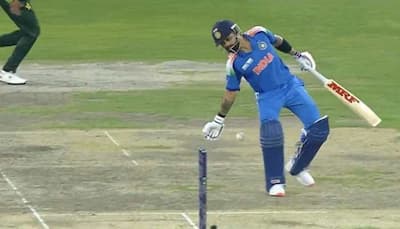EXPLAINED: Was Virat Kohli Out On 41 Against Pakistan? Understanding ‘Obstructing the Field’ Rule
Virat Kohli’s record-breaking 51st century helped India seal a commanding six-wicket win over Pakistan in their high-voltage Champions Trophy 2025 encounter. However, in a moment of controversy, the Indian maestro could have seen his innings end prematurely due to a potential ‘Obstructing the Field’ dismissal. Sunil Gavaskar, commentating on the match, was visibly frustrated by Kohli’s actions and suggested that he was fortunate that Pakistan did not appeal.
During the 21st over of India’s run chase, Kohli pushed a delivery from Haris Rauf towards the off-side and darted for a quick single. As the ball was thrown towards the stumps, Kohli, having already made it safely to the crease, reached out with his hand to stop the ball.
Sunil Gavaskar was quick to react, stating, “He stopped the ball with his hand. If the Pakistanis had appealed, it could have been ‘Obstructing the Field.’ Maybe nobody was backing up at that stage, but there was no need for him to interfere.” Former Pakistan skipper Rameez Raja, who was in the commentary box alongside Gavaskar, found irony in the situation, given that he had just praised Kohli’s remarkable game awareness.
The ‘Obstructing the Field’ rule is one of the rarest modes of dismissal in cricket. According to Law 37 of the MCC rulebook, a batter is out if they willfully obstruct or distract the fielding side by word or action. Specifically, a player can be ruled out if they deliberately use a hand not holding the bat to strike the ball, except when protecting themselves from injury.
Instances of this dismissal are rare but not unheard of. In 2006, Inzamam-ul-Haq was given out against India when he used his bat to block a throw aimed at the stumps. Similarly, in 2015, Ben Stokes was dismissed against Australia for stopping a throw with his hand while outside his crease.
While Kohli’s act of stopping the throw may have appeared unnecessary, it wasn’t an outright violation of the rule. Since he was safely inside his crease and did not actively interfere with a fielder’s ability to complete a play, an appeal may not have been upheld. However, it was still a risky move that could have led to unnecessary controversy had Pakistan chosen to appeal.
The moment has sparked discussions among fans and experts alike, with many questioning whether Kohli’s action was instinctive or a miscalculated attempt to prevent an overthrow.
Despite the controversy, Kohli’s innings was nothing short of masterful. His 100* off 111 balls guided India to a comfortable chase of Pakistan’s 241-run target. In the process, Kohli achieved yet another milestone, becoming the third-highest run-scorer in ODI history, surpassing Ricky Ponting and trailing only Sachin Tendulkar and Kumar Sangakkara.
Earlier in the match, Pakistan had a solid start with Saud Shakeel (62) and Mohammad Rizwan (46), but a middle-order collapse, triggered by Kuldeep Yadav (3/40) and Hardik Pandya (2/31), restricted them to 241 in 49 overs.
India’s chase wasn’t entirely smooth, with Shaheen Afridi dismissing Rohit Sharma (20) early and Abrar Ahmed breaking a promising stand by dismissing Shubman Gill (46). But Kohli, with able support from KL Rahul (38), anchored the innings and took India home with ease.
Stay informed on all the , real-time updates, and follow all the important headlines in and on Zee News.
